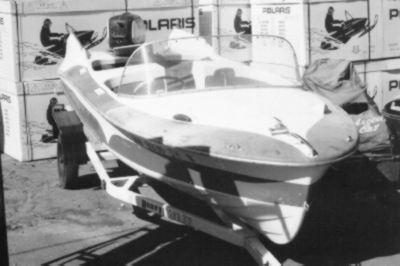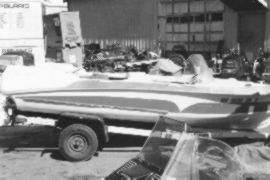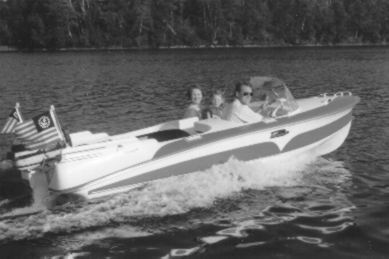By Lee Wangstad
Where in the world do you start something like this? Write about me? Eric Gustavson has been after me for this since he cornered me at the Treasure Island show last August. Maybe corner is too harsh a word. Corner is just not his style. Let’s use the word persuaded. He’s a tough guy to say no to. This, coupled with the fact that I’m basically a pushover type, sets up the scenario. It came as no surprise that he sent a follow up letter a month or so later to kind of rekindle the fire under me, or maybe just build a little harmless guilt. Not that this would have a very immediate effect either, being of true Minnesota Norwegian/German heritage, suppressing guilt is almost second nature for me.

How Sad!! Behind Donahue’s in Delano As I’m pulling my 1957 Larson Thunderhawk into the Convention Center for the Minneapolis Boat Show, who should I run into but Eric himself. I suddenly realize that it’s now January, and I’m still no closer to having this story ready than I was in August. I convince myself that I will do it; I’ll let nothing stand in my way! Guilt triumphs once again in my life. So, here goes, Eric…better late than never.
I live in rural Nisswa, Minnesota. I’m sure that some of you have been to Nisswa and consider the town a rural area in itself, but I live about 12 miles southwest of town on Agate Lake with Nancy, my spouse, and our daughter Emily. Life is kind of slow in these parts, and that is the pace that we have become accustomed to. We moved up here from the Twin Cities 18 years ago this spring. The plan was to get a couple of years of construction experience in the small-town atmosphere and then moving back to the more exciting life of the city dweller, only with more experience.
I guess it just wasn’t meant to happen that way. We found a great building site on Agate Lake and within three years of moving to the area had ourselves a house on the lake. What we didn’t have was a boat. We had a canoe, but what I really needed was something that had some get up and go; something with some speed and style.
One day back in October of 1984, while cruising through Delano, I spotted a red and white Larson Thunderhawk behind Butch Donahue’s Harley shop on Highway 12. At first I didn’t realize what was happening. My truck was actually pulling itself right off the road and into Butch’s parking lot, amazingly enough, right next to the old Larson. One look and I was absolutely convinced that this was actually the same boat my father had bought new in 1958. Upon closer inspection, I realized that it wasn’t our old boat. Our boat had been in the family from 1958 until 1967 and would have borne the scars of those nine years of hard duty without any shame. As I ran my hands over that boat, I couldn’t feel any of the repairs that would have been necessary to heal our old boat. Every nick and gouge in our old Thunderhawk was indelibly stamped into my memory from the moment of occurrence. Nonetheless, this boat was in rough condition as ours was sure to be, but in its favor, most of the hard to get stuff was there.
When I entered Butch’s store, the first thing that hit me was the impressive collection of old Harleys and Indians on display. The immediate sinking feeling in my stomach came as it became apparent he was into restorations – really nice restorations – and probably wouldn’t want to part with this old Larson.

Lost in Snowmobile Land! When I asked him about the Larson, Butch said that he was playing around with the idea of fixing it up to use for himself. One of the guys who worked for him had brought it out onto Lake Minnetonka a couple of weeks back and said that it ran pretty good, so it did run. Even though I didn’t have any money with me, I asked him if he would consider selling it. He thought it over for a while and said sure, why not? Next came the part that would either send me home justified for stopping, or else feeling foolish for even considering being there in the first place. It was time for the inevitable “how much” question. He kicked it around for awhile and conceded to me that he was looking to get $200. I think that he could tell just how excited I was about the boat, and was really giving me a huge break. While this might not seem like much for a boat with a motor that ran, for me, struggling to pay for a new house, it might as well have been a million. I wanted it sooooooooo bad! Nancy and I had some long discussions concerning the boat. I had gone to the trouble to take pictures while I was there and kept bringing them out to look at and show her. We tend to make all of our major decisions together, and for us at this point in our lives, this was pretty major. We figured out how we could budget enough to buy the boat, but with Nancy’s birthday coming up, would she be willing to sacrifice the new loafers that she had been eyeing in the L.L. Bean catalog? She very willingly made the call and I went down to Delano and brought the boat home. Eventually, Nancy did get her new loafers, although we kidded about the boat being her birthday present for many years after.

Shortly after restoration on Sylvan Lake.
Over the next couple of years I would occasionally get it in the water and use it on our lake, closing my eyes and dreaming of the day when it would look like brand new again. I would work on the boat as time allowed, never letting it take control of my life.
In all, it took six years to complete the restoration, doing all of the work myself. I did have the gelcoat shot at a professional shop as I lacked the equipment to do that. However, I did do all of the prep work and all of the finish sanding and polishing, saving myself close to $3,000. I learned a lot of new skills in the process of this restoration. Perhaps the most rewarding was the research involved to make it correct.
While working on my Thunderhawk, I came to know Bob Speltz, who would help me gather the information on Larson Boat Works that I needed for my restoration. I met Bob while at his show in Albert Lea in 1989. He was always so willing to share the information that he had. It seemed that he was always there, and he always had the time to listen. The key word here is always. And it didn’t matter if we were talking about a wood boat or fiberglass boat. We even had some great conversations about pontoon boats, but he had a certain way of getting the excitement running. The closer I came to know him, the higher the intensity level rose to gain more information. He had a way of compelling you to learn more. Bob had become a mentor to me, not only in his expertise surrounding the great wooden classics which he knew so much about, but also, more than anything, about sharing.
He was very generous in sharing with the world the knowledge he had accumulated on the great wood boats. But for me, he went overboard in the generous department. He gave me what has to be the most comprehensive collection of 50’s, 60’s, and 70’s marine factory literature assembled in one place on earth. I thought I had assembled a pretty neat collection of old literature until Bob and I spent a long Saturday going through the stacks of material in his attic. The amount and quality were staggering to say the least. Shortly after I returned home with this great collection, Bob passed away. I was crushed. Selfish at first, I was thinking of the questions that I hadn’t asked and now would never be able to. Bob’s funeral brought closure for me with the celebration that he had all planned out, down to the last detail. I use the word celebration in effect as everyone there seemed to be in awe just for the time they were able to spend with this great person. As for any questions I may have had, Bob had told me that research came easy if you were really in touch with your subject.
About a year after Bob had left us, I started to write the “Classic Boat” column for Boating World magazine, with my first article appearing in the Summer 1994 issue. I used the literature Bob had given to me for background material and art work to illustrate these articles. Most of these articles have been centered around the post World War II marine industry and the boating boom of the fifties. While a lot of the players in this game are now gone forever, I have been extremely fortunate to locate and interview many of the leaders of the industry during those years of rapidly changing styles and tastes, when boating was reaching epidemic proportions. This first-hand information has become critical to me in putting the industry into perspective against the backdrop of the cultural revolution taking place in America at the time.
The people that were in leadership roles in the industry during the 50’s are a rapidly-aging group, most now in their 70’s and 80’s, frail only in terms of their age. They are a tough group, having survived years of intense competition. They took a wild roller coaster ride in an industry that was totally dependent on an economy that could turn overnight, and was often one of the first businesses impacted by a downturn. But, to a person, they all enjoyed their work. They loved the boat-building business, the people they were involved with, and the market they brought their products to. These are my heroes.
In the following issues of The BoatHouse, I will share those stories I have researched in hopes that a broader spectrum of classic boaters will come to enjoy and understand those boats. While not our traditional mahogany planked wood boats, they are being restored and enjoyed by a new generation of classic boating enthusiasts. Isn’t that what it’s really all about?

